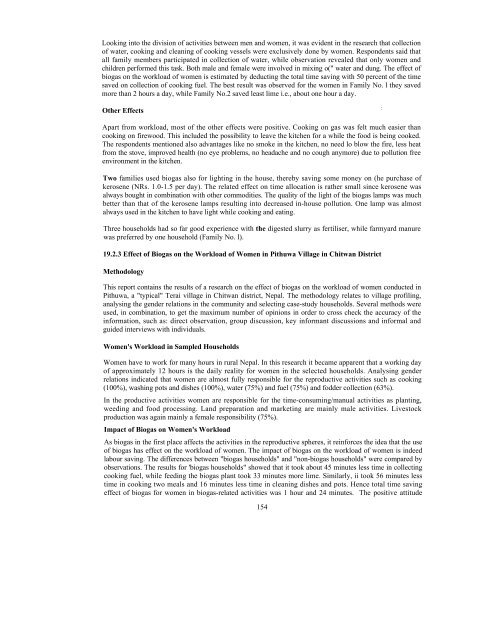download (pdf, 6MB) - SNV
download (pdf, 6MB) - SNV
download (pdf, 6MB) - SNV
You also want an ePaper? Increase the reach of your titles
YUMPU automatically turns print PDFs into web optimized ePapers that Google loves.
Looking into the division of activities between men and women, it was evident in the research that collection<br />
of water, cooking and cleaning of cooking vessels were exclusively done by women. Respondents said that<br />
all family members participated in collection of water, while observation revealed that only women and<br />
children performed this task. Both male and female were involved in mixing o(" water and dung. The effect of<br />
biogas on the workload of women is estimated by deducting the total time saving with 50 percent of the time<br />
saved on collection of cooking fuel. The best result was observed for the women in Family No. l they saved<br />
more than 2 hours a day, while Family No.2 saved least lime i.e., about one hour a day.<br />
Other Effects<br />
:<br />
Apart from workload, most of the other effects were positive. Cooking on gas was felt much easier than<br />
cooking on firewood. This included the possibility to leave the kitchen for a while the food is being cooked.<br />
The respondents mentioned also advantages like no smoke in the kitchen, no need lo blow the fire, less heat<br />
from the stove, improved health (no eye problems, no headache and no cough anymore) due to pollution free<br />
environment in the kitchen.<br />
Two families used biogas also for lighting in the house, thereby saving some money on (he purchase of<br />
kerosene (NRs. 1.0-1.5 per day). The related effect on time allocation is rather small since kerosene was<br />
always bought in combination with other commodities. The quality of the light of the biogas lamps was much<br />
better than that of the kerosene lamps resulting into decreased in-house pollution. One lamp was almost<br />
always used in the kitchen to have light while cooking and eating.<br />
Three households had so far good experience with the digested slurry as fertiliser, while farmyard manure<br />
was preferred by one household (Family No. l).<br />
19.2.3 Effect of Biogas on the Workload of Women in Pithuwa Village in Chitwan District<br />
Methodology<br />
This report contains the results of a research on the effect of biogas on the workload of women conducted in<br />
Pithuwa, a "typical" Terai village in Chitwan district, Nepal. The methodology relates to village profiling,<br />
analysing the gender relations in the community and selecting case-study households. Several methods were<br />
used, in combination, to get the maximum number of opinions in order to cross check the accuracy of the<br />
information, such as: direct observation, group discussion, key informant discussions and informal and<br />
guided interviews with individuals.<br />
Women's Workload in Sampled Households<br />
Women have to work for many hours in rural Nepal. In this research it became apparent that a working day<br />
of approximately 12 hours is the daily reality for women in the selected households. Analysing gender<br />
relations indicated that women are almost fully responsible for the reproductive activities such as cooking<br />
(100%), washing pots and dishes (100%), water (75%) and fuel (75%) and fodder collection (63%).<br />
In the productive activities women are responsible for the time-consuming/manual activities as planting,<br />
weeding and food processing. Land preparation and marketing are mainly male activities. Livestock<br />
production was again mainly a female responsibility (75%).<br />
Impact of Biogas on Women's Workload<br />
As biogas in the first place affects the activities in the reproductive spheres, it reinforces the idea that the use<br />
of biogas has effect on the workload of women. The impact of biogas on the workload of women is indeed<br />
labour saving. The differences between "biogas households" and "non-biogas households" were compared by<br />
observations. The results for 'biogas households" showed that it took about 45 minutes less time in collecting<br />
cooking fuel, while feeding the biogas plant took 33 minutes more lime. Similarly, ii took 56 minutes less<br />
time in cooking two meals and 16 minutes less time in cleaning dishes and pots. Hence total time saving<br />
effect of biogas for women in biogas-related activities was 1 hour and 24 minutes. The positive attitude<br />
154
















